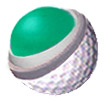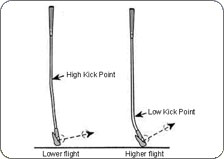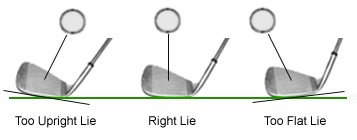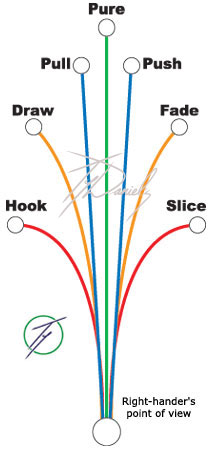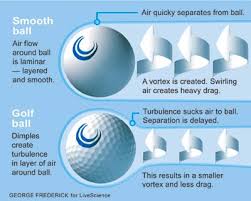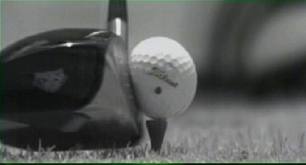The Best Coaches Understand Equipment Too!
Written by Jeff Hatton, EGTF Master Teaching Professional and Master Club Maker
Are you a good coach? Want to be a great coach?
If you really don’t understand the role equipment plays in executing golf shots you should definitely try to gain this knowledge to enable you to become a better golf coach? Having a sound knowledge of equipment and how it influences ball flight is vital to becoming a great coach. If the equipment is wrong for the player you can be doing more harm than good in your lessons!
Some basic examples of equipment related issues:
Scenario 1: Player came along for an equipment MOT. He had been working with a local coach trying to improve his ball trajectory as he was hitting it too high. He’d had three lessons all with a 7 iron (wrong) trying to get the trajectory down as his coach said he was scooping the ball in the air. One strike on a lie check board showed that the impact position was if fact reasonable and not scooping, but the ball was still carrying too much back spin and launching too high. His coach however had failed to spot something very obvious that would make their objective very difficult to achieve!
The player was using a very large game improver cavity backed iron, a very soft superlite shaft with a low kick point. This club’s sole purpose is to get the ball high in the air and yet his coach was trying to get him to hit it lower. The net effect of this 7 iron coaching is that the player now hits down on his driver too, creating very high back spin and launch angles and is also trying to fight the design of his irons.
Scenario 2: Player was having difficulty with his wedge play, he couldn’t find the greens but the rest of his game was OK. Again he’d had lessons to try and correct the fault but was still struggling. One swing on a lie check board showed the lie angle to be around four degree out. If the lie angle is out on any lofted club the player will struggle to hit it straight!
If the lie angle is out, change the club before attempting any swing corrections. Lie check boards, essential tools for any teaching professional.
Scenario 3: Player was struggling for consistency when driving. Most shots were a push fade with the occasional snap hook. However, he was more consistent with his 3 wood. Both clubs had regular shafts fitted.
As a coach we know there are several likely swing causes for this problem but what equipment issues could also contribute? In this instance the flex of both clubs were measured for CPM using a frequency meter, the 3 wood came up as a mid regular, the driver registered a soft senior flex and was particularly soft in the tip section. The soft shaft in the driver was undoubtedly the cause of the players club face timing issues.
As a coach how do you correct this in the swing? The simple answer is, you cannot! Whilst the equipment is not fit for purpose giving a lesson is a pointless exercise and likely to make you look less than competent.
What is written on a shaft is unlikely to represent what flex the shaft really is. All shafts should carry the label BS and we all know what that stands for. Most but not all premium shafts usual do ‘what it says on the tin’.
Scenario 4: A mid handicapper was having trouble finding the middle of his driver clubface. A simple solution would be to shorten the driver as most off-the-shelf clubs measure up at 46 inches long. Firstly long clubs inhibit swing speed and they also encourage off centre hits. Cutting the driver length will help but be mindful of the swing-weight it may be too light afterwards. What if after cutting the driver down the problem persists? Oscillation, this is a swear word amongst the OEM fraternity and they will not admit it exists. Watch the video link below, as club maker we correct these problems all the time, as a coach it’s important to know it exists.
https://www.youtube.com/watch?v=x-xYq9etlEo&feature=youtube_gdata_player
This is my pet subject; I see it on a daily basis with off the shelf clubs. Sometimes I’m able to pull the head turn the shaft and re-glue, the club is transformed. Most often a new shaft is required but it will still be pured and flowed before assembly.
Scenario 5: Do you know the difference between a Tour spec driver head and a standard one apart from the price? One such example is the Taylor made RBZ driver. The tour head version will produce up to 1000 RPM less back spin than the standard head. Trying to teach a strong player how to improve their flight trajectory (less back spin) with a game improver head is going to be a long and painful exercise!
Scenario 6: Balls. As a coach we know that all balls are round and they have dimples on them and that is where the similarity ends. Different balls will benefit different players.
Do we understand compression and what is the difference between a two piece ball and a four piece ball apart from the price?
One Piece balls are typically used on driving ranges. They are more durable offer lower spin rates and reduced distance.
Two Piece balls are typically your game improvement or distance balls. The large core provides a lot of velocity when struck. Mid compression ball
3/4 Piece premium balls are for low handicap and professional golfers with high swing speeds who need a ball with low initial spin and a softer feel around the greens. High Compression ball
Golf balls are designed for different swing speeds. A higher compression ball requires a higher swing speed to compress the ball a certain amount. And, for drives to get the maximum distance out the ball, you want to be able to compress the ball enough that the core of the ball is compressed.
Changing golf ball for a client can lead to improved distance!
These are just a few examples, understanding them is vital to offering a good service!
We don’t all have the benefit of launch monitors and workshop measuring equipment, but if we can see potential issues with equipment that might be holding back our student then you can offer the advice to help improve their chances of success thereby making your customer service even better to your clients. Giving lessons to students using unsuitable equipment will make the end we are looking for more difficult to achieve, they need to understand these ideas so they are not wasting their own time and money . Get their clubs corrected first then fix their swing!
As coaches we all want to help our students, understanding the role equipment plays will make you a better coach. Offer your students the complete lesson package; know your equipment as well as the golf swing.
Hatton Golf offer 1-2-1 CPD training courses to all EGTF members. Become a better coach.

